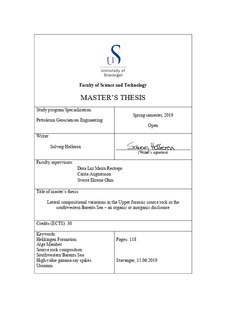| dc.contributor.advisor | Marín Restrepo, Dora Luz | |
| dc.contributor.advisor | Augustsson, Carita | |
| dc.contributor.advisor | Ohm, Sverre Ekrene | |
| dc.contributor.author | Helleren, Solveig | |
| dc.date.accessioned | 2019-09-30T12:15:46Z | |
| dc.date.available | 2019-09-30T12:15:46Z | |
| dc.date.issued | 2019-06 | |
| dc.identifier.uri | http://hdl.handle.net/11250/2619398 | |
| dc.description | Master's thesis in Petroleum Geosciences Engineering | nb_NO |
| dc.description.abstract | Prominent high-value gamma-ray spikes in the maximum flooding surfaces of the Alge Member of the Hekkingen Formation display an uncommon stratigraphic and regional variation in the southwestern Barents Sea. The variation in the gamma-ray spikes indicates compositional variation in the Alge Member, thus, challenging the common perception that the Upper Jurassic source rock is a homogenous succession of black shale. The purpose of this study is to identify the compositional variation in the source rock that causes the high-value gamma-ray spikes in the Alge Member, and by comparing the lateral compositional changes in the Alge Member – be able to develop an improved understanding of the depositional environment and the paleogeography in the area during deposition. This study integrates data from X-ray diffraction of clay minerals, geochemical analysis, maceral analysis, seismic reflection data, well logs and sedimentary core logs.
The studied compositional elements of the Alge Member show no correaltion to the high-value gamma-ray spike. However, their geographical distribution correlates with the depositional environments interpreted from the sedimentary core logs and the seismic facies observed in the Alge Member. West and northwest of the Loppa High, the composition of the Alge Member reveal that the deposition of the member was influenced by the ongoing rifting and uplift of the Loppa High. Whereas, in the Hammerfest Basin and in the area eastward toward and surrounding the Nordkapp Basin, the Alge Member experienced a low energy deposition in hypoxic to anoxic bottom conditions.
The high-value gamma-ray spikes are present when the Alge Member has been deposited in a hypoxic to anoxic environment. Moreover, the high-value gamma-ray spikes correlate to the uranium content in the member. The conditions that are required for uranium precipitation in the sediments could be used to reconstruct the development of the anoxic zone in the southwestern Barents Sea during the deposition of the Alge Member. | nb_NO |
| dc.language.iso | eng | nb_NO |
| dc.publisher | University of Stavanger, Norway | nb_NO |
| dc.relation.ispartofseries | Masteroppgave/UIS-TN-IER/2019; | |
| dc.rights | Navngivelse 4.0 Internasjonal | * |
| dc.rights | Navngivelse 4.0 Internasjonal | * |
| dc.rights.uri | http://creativecommons.org/licenses/by/4.0/deed.no | * |
| dc.subject | petroleumsgeologi | nb_NO |
| dc.subject | Hekkingen Formation | nb_NO |
| dc.subject | Alge Member | nb_NO |
| dc.subject | source rock composition | nb_NO |
| dc.subject | high-value gamma-ray spikes | nb_NO |
| dc.subject | uranium | nb_NO |
| dc.subject | southwestern Barents Sea | nb_NO |
| dc.subject | petroleum geology | nb_NO |
| dc.title | Lateral compositional variations in the Upper Jurassic source rock in the southwestern Barents Sea – an organic or inorganic disclosure | nb_NO |
| dc.type | Master thesis | nb_NO |
| dc.subject.nsi | VDP::Technology: 500::Rock and petroleum disciplines: 510::Geological engineering: 513 | nb_NO |
| dc.subject.nsi | VDP::Mathematics and natural science: 400::Geosciences: 450::Petroleum geology and petroleum geophysics: 464 | nb_NO |

